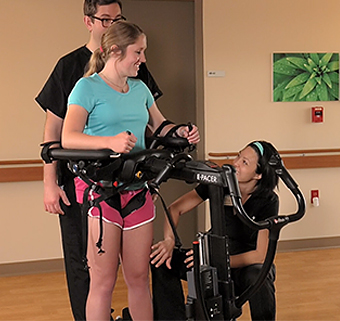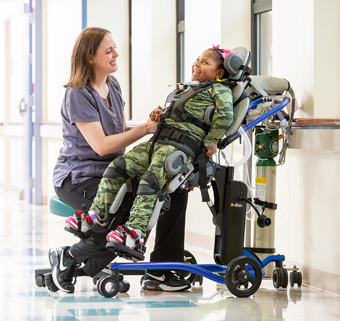P-PAS, Adaptive Equipment and You
Assessment, Adaptive Equipment Choices, and Implementation Strategies for the Classroom and Home
| December 2019 The Posture and Postural Ability Scale or P-PAS (Rodby-Bousquet, et al., 2015)¹, is a tool that can be used to assess posture, postural ability and the quality of posture in prone, supine, sitting and standing positions.
The Posture and Postural Ability Scale or P-PAS (Rodby-Bousquet, et al., 2015)¹, is a tool that can be used to assess posture, postural ability and the quality of posture in prone, supine, sitting and standing positions.
Posture, in this context, refers to the anatomical alignment of body parts in relationship to each other and the environment. Postural ability is defined as a person’s ability to stabilize the body’s segments relative to each other and a stabilizing surface in order to assume the most appropriate body configuration to complete a particular task within an environment. (Rodby-Bousquet et al. 2014)². The P-PAS has excellent inter-rater reliability, internal consistency and construct validity (Rodby-Bousquet et al. 2012)³, making it useful for assessing the postural ability of clients with significant physical disabilities. The client’s postural ability depends on his or her ability to be placed in, and move in and out of positions, and is classified on a seven-tiered scale. At Level 1, the client cannot be placed in an aligned position, and at Level 7, the client easily moves from a position. Quality of posture is scored “Yes” or “No” and takes weight distribution in all four positions into consideration using the sagittal and frontal view of the body.
Let’s consider the utility of the P-PAS for school students who are required to participate in a variety of activities during the school day. Generally, the positions needed are sitting and standing, although preschoolers might need to lie down if their program includes a nap time. Adaptive equipment is a critical support to correct positioning in all positions and facilitates participation. Adaptive chairs and standers offer mechanical supports that can be added and moved to support body segments to foster the most appropriate alignment and allow optimal access to activities. The P-PAS level identification and quality score can be used to position a student appropriately as part of services to a student, and used as a training tool as part of services on behalf of a student within the IEP process.
Let’s use as our example the previously discussed student with mid-thoracic trunk control challenges per SATCo testing. As a service to the student, we now use the P-PAS to determine what postural ability level and quality score the student has while sitting on a bench during the circle time activity. Based on observation, we determine the student is a P-PAS Level Four, meaning we can anticipate the student to correct a forward and backward lean while seated on the bench. While the student is sitting quietly waiting her turn, we assess the quality of that seated position using the P-PAS scoring mechanism from both the frontal and sagittal view.
Once completed, each element of the tool and your scoring can be shared with classroom staff. This provides a powerful training tool for follow through with the layperson’s ability to position a student correctly in an ongoing way. The P-PAS scoring information can be turned into a data collection sheet used to track the student’s correct position while guiding and training classroom staff on their positioning effectiveness and their fidelity with equipment use.
Approaching student positioning in this way can foster classroom staff confidence in appropriate positioning and correct alignment of the physically challenged student using any piece of adaptive equipment. As with SATCo, different positions are required to access different activities, and this requires careful observation by the clinician, with the potential for different postural ability levels and quality scores in varying contexts.
For a family who has been encouraged by their early intervention provider to stand their one-year-old at home to engage in playtime with a sibling, a stander with accessories can be used as an intervention. Using the postural ability level as a starting point, followed by determining the quality of the child’s position in standing, the family can be instructed to position their child correctly using the stander and to understand what good alignment looks like. This approach builds the family’s confidence in their ability to physically manage their child and implement the adaptive equipment with fidelity. If the child is using adaptive seating for eating and drinking or to manipulate objects, the P-PAS postural ability level and scoring mechanism for quality can again be used to determine appropriate alignment to facilitate the best opportunity for child engagement and access.
As a clinician, I encourage you to consider using this tool to support your work with clients in the home and in school in order to fully understand their postural control challenges and address their postural ability in an evidence-based way.
References
- Rodby-Bousquet E, Agústsson A, Jónsdóttir G, Czuba T, Johansson AC, Hägglund G. (2014) Interrater reliability and construct validity of the Posture and Postural Ability Scale in adults with cerebral palsy in supine, prone, sitting and standing positions. Clin Rehabil. 28(1):82-90. Free Full Text https://journals.sagepub.com/doi/pdf/10.1177/0269215512465423
- Rodby-Bousquet E, Persson-Bunke M, Czuba, T. (2015) Psychometric evaluation of the Posture and Postural Ability Scale for children with cerebral palsy. Clin Rehabil. 30(7):697-704. Free Full Text http://citeseerx.ist.psu.edu/viewdoc/download?doi=10.1.1.1017.7503&rep=rep1&type=pdf
- Rodby-Bousquet, E, Agustsson, A, Jónsdóttir, G, Czuba, T, Johansson, A, Hägglund, G. (2012). Interrater reliability and construct validity of the Posture and Postural Ability Scale in adults with cerebral palsy in supine, prone, sitting and standing positions. Clinical rehabilitation. 28(1):82-90. Free Full Text https://www.researchgate.net/publication/233798962







